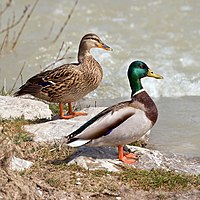
Photo from wikipedia
Rather than migrating, mallard ducks may choose to overwinter in northern cities on open-water thermal refuges, such as municipal wastewater treatment ponds, which in Edmonton, Canada, stay ≥10°C during frigid… Click to show full abstract
Rather than migrating, mallard ducks may choose to overwinter in northern cities on open-water thermal refuges, such as municipal wastewater treatment ponds, which in Edmonton, Canada, stay ≥10°C during frigid winter months. Refuging mallards spend appreciable time daily on these ponds and hydrate using secondary clarified municipal wastewater (SCEW). We aimed to determine if SCEW ingestion affected mallard health. To this end, we gavaged newly hatched mallards (domesticated Pekin strain) over their first month with SCEW, as well as water representing negative and positive controls (municipal tap water, and the primary active ingredient from birth control pills, 17α-ethinyl estradiol (EE2), respectively). The gavage of SCEW did not affect mass of the body, liver, spleen or heart, but was associated with small increases in beak and wing chord length. In the positive control, EE2 gavage caused similar responses, but also increased tarsus and phallus length. The increases likely owed to the stimulatory effects of estrogenic substances on bone and phallus development. For the biotransformation enzyme CYP2H1, gene expression was numerically increased by both SCEW and EE2. In terms of behavior, SCEW and EE2 gavage reduced two infrequently detected behaviours, pecking and resting alone. Our results suggest that SCEW ingestion would be unlikely to cause any overt health effects in adults, but may evoke subtle, covert effects nevertheless.
Journal Title: Ecotoxicology and environmental safety
Year Published: 2017
Link to full text (if available)
Share on Social Media: Sign Up to like & get
recommendations!